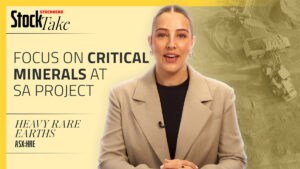CRITERION: A beaten up uranium stock at 1/10th the average resource value? That’s a glowing recommendation

Tim Boreham is one of Australia's best-known small-cap share analysts and business journalists.
We hear the mood among the 550 delegates at last week’s World Nuclear Symposium in London was positively glowing – and there are good reasons why, given the uranium sector’s gathering momentum.
Supportive factors include dwindling inventories, a coup in uranium-producing Niger and Canadian giant Cameco curtailing guided production due to a lack of qualified operating staff (sounds like our railways).
At 180 million pounds, the uranium inventories of US and European utilities are at their lowest levels since 2008 and these power stations are expected to start buying.
Broker UBS notes the spot uranium price has traded above $US61 ($95) a pound in September – a 12-month high. The firm opines that while there is “much uncertainty on the demand and supply sides,” it expects the price to hit $US70/lb next year.
Meanwhile, the West – especially the US – remains scarily dependent on supply from Russia and its ally Kazakhstan.
Trade in Russian oil, vodka and caviar might have been curtailed because of sanctions, but uranium continues to flow freely. However it won’t be such a (yellow) cakewalk if Vladimir decides that curtailing supply will hurt the West more than Russia’s balance sheet.
With current US domestic uranium production at next to nothing, Aurora Energy Metals (ASX:1AE) is in an interesting position as it seeks to develop its unimaginatively monikered Aurora Energy Metals Project (AEMP) in southern Oregon, near the Nevada border.
Aurora managing director Greg Cochran dubs AEMP as the biggest deposit in the US – or the biggest mineable one (there’s a bigger one in Virginia, but subject to the state’s 40-year-old uranium moratorium).
Aurora listed in May last year on the back of the project, which Cochran describes as a “large, well-defined deposit with a clear pathway to development.”
The deposit is not new – it was discovered in the 1970s – and Aurora avails 90,000m of previous drilling over 700 holes that would cost $75 million to replicate.
Off its own bat, Aurora recently completed an inaugural diamond drill and reverse circulation drilling program, to shore up a resource of 50.6 million pounds of uranium oxide.
The resource is also 65 per cent measured, the highest confidence category. While the grade is a tad low, the soft material should be easy to mine and the initial focus is on a high-grade zone of 19.2 million pounds.
Aurora is striving for pre-feasibility study by the end of 2024, in view of a 1.5 million-pounds-per-annum operation over 10-15 years.
While that all sounds wildly positive, Aurora shares are well under their 20c listing price in May last year. A key reason is that the company talked up the lithium prospectivity of the project, but by joining the battery metals bandwagon the company simply confused investors.
Broker (and float lead manager) Euroz Hartleys says Aurora’s enterprise value of a mere $9 million values the AEMP resource at 23c/lb in the ground, well below the peer average of $2.50/lb.
Aurora Energy share price charts
A pertinent comparator is the ASX-listed US based peer Peninsula Energy (ASX:PEN), which was about to fire the starter’s gun on its Lance project in Wyoming cowboy country.
In July Peninsula revealed its processing partner Uranium Energy Corp had pulled out, sending its shares down 44 per cent. Still, the market values Lance’s 16 million tonnes of contained uranium at around $8 a pound.
Peninsula will now pursue in-house processing, which will result in “significant delays” but eventually could enhance the project’s value.
Euroz Hartleys values the “heavily beaten up” Aurora shares at 32 cents, more than four times their current worth.
With a market cap of $110 million backed by $32 million of cash, Peninsula could also be a cut-price route to glowing investment success.
The views, information, or opinions expressed in the interviews in this article are solely those of the interviewees and do not represent the views of Stockhead. Stockhead does not provide, endorse or otherwise assume responsibility for any financial product advice contained in this article.
This story does not constitute financial product advice. You should consider obtaining independent advice before making any financial decisions.
Related Topics

UNLOCK INSIGHTS
Discover the untold stories of emerging ASX stocks.
Daily news and expert analysis, it's free to subscribe.
By proceeding, you confirm you understand that we handle personal information in accordance with our Privacy Policy.








